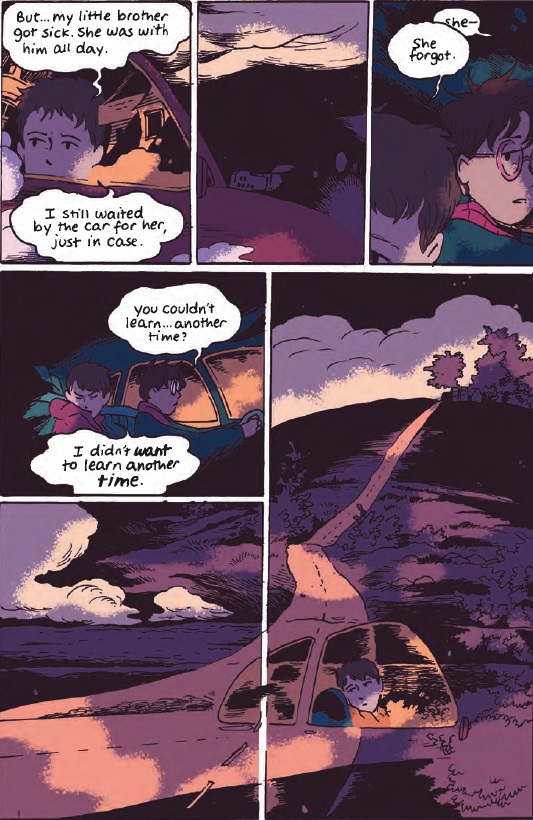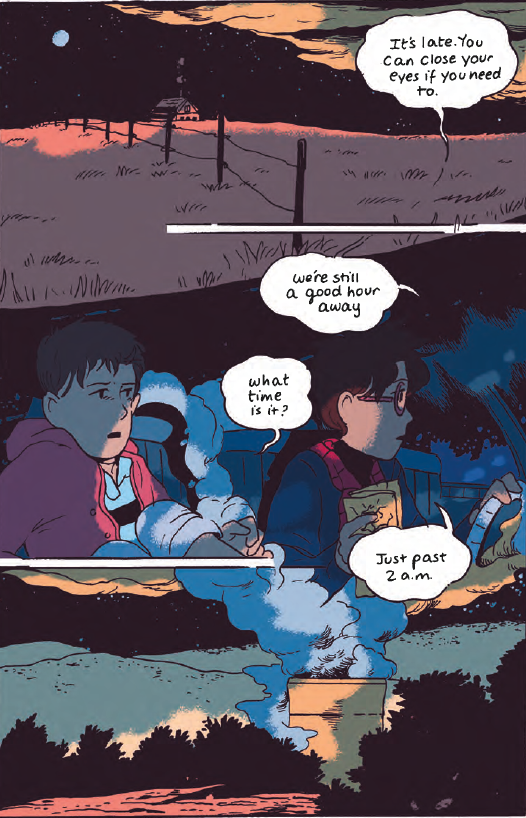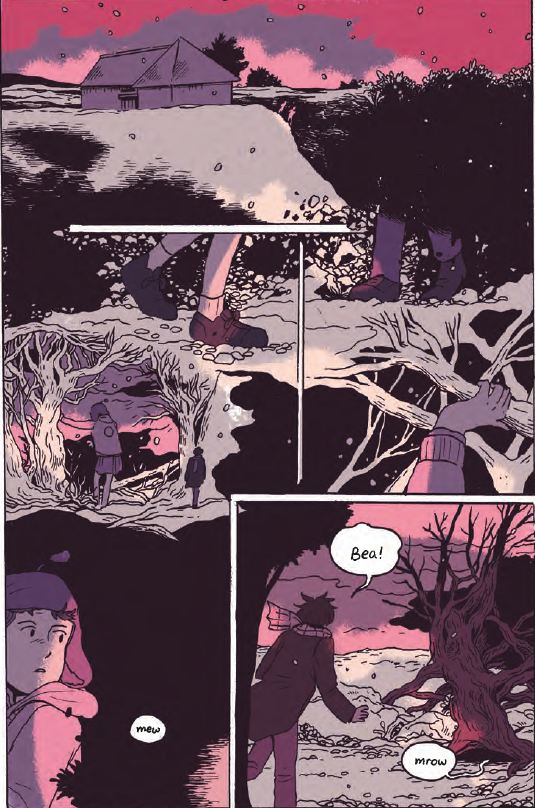Tillie Walden’s new book, Are You Listening?, is relatively unambitious compared to her previous one, given that it’s just a smidge over 300 pages. That’s a joke and a true statement at the same time. Listening genuinely isn’t as long or as complex as On a Sunbeam, which was nearly 540 pages of multiple timelines and a host of characters in an outer-space setting. At the same time, Walden’s pace and productivity continue to astonish. Given that On a Sunbeam came out early last October, it is sort of ridiculous that Are You Listening? followed less than a year later, especially given that it is in color. Two years ago, she put out Spinning, an autobiographical story about her competitive figure-skating years and her process of coming out. I’m sure she’s tired of hearing about her work ethic (although she does wake up at 4 a.m. to draw) and her prodigy-type status in the comics world (she was asked to do her first book at the age of 17), and there are parts of Are You Listening? that address those feelings, just not head on.
Walden doesn’t seem to like to approach things squarely. There was a bit of that in Spinning, probably because of the topic, but mostly she prefers to suggest rather than to taxonomize. In On a Sunbeam, that elliptical tendency was frustrating. The book was too big, too soft around the edges. It was undeniably interesting, but the outlines weren’t clear. Her work doesn’t look like Farel Dalrymple’s if you were to compare their drawings side by side, but they have a similar focus on liminality that makes me feel itchy (not a criticism of their work so much as a criticism of my own deep-rooted desire for clarity). Are You Listening? is a good midpoint between Walden’s previous two books. It’s not as abstruse as On a Sunbeam, not as simple as Spinning.
 There’s plenty of shimmery weirdness, mind you. The story brings together two women: the teenaged Beatrice (who goes by Bea) and the 27-year-old Lou, as the latter lets the former hitch a lift through an imaginary west Texas. Bea learns to drive. Lou, a gifted mechanic, learns to let go a little. Pursued by some creepy dudes with glowing eyes, they find a mysterious cat and try to return her to her home. They tell each other meaningful stories about their childhoods, and Bea reveals why she’s on the road.
There’s plenty of shimmery weirdness, mind you. The story brings together two women: the teenaged Beatrice (who goes by Bea) and the 27-year-old Lou, as the latter lets the former hitch a lift through an imaginary west Texas. Bea learns to drive. Lou, a gifted mechanic, learns to let go a little. Pursued by some creepy dudes with glowing eyes, they find a mysterious cat and try to return her to her home. They tell each other meaningful stories about their childhoods, and Bea reveals why she’s on the road.
There’s a story about how Lou built a whole car when she was 15, but she’s not excited to tell it. That sounds a bit like her creator. Those echoes get a lot louder when Lou says, “I spent my early twenties working so hard and so fast… and I never once asked myself how I was doing it all. And now I’m fucking paralyzed, but I don’t know how to deal with it because I’ve never let myself slow down before.” Bea asks, “You mean you don’t want to be a mechanic anymore?” and Lou replies, “No, no… I still love what I do. And that used to be enough. Now it’s… not.”
 Walden colors her pages in pinks, lavenders, blues, and the occasional orange, rendering patchy shadows; everything sort of bleeds into everything else in the twilight and the dark, just like your eyesight starts to go at those times of day. What is that over there in the corner, and should you be afraid of it? Squinting doesn’t help. Scenes in the daytime are clearer, but there aren’t as many of them. The story is more effective in darker spaces, when weird magic seems more possible. Walden’s word balloons have spidery tails that meander over to the person who’s speaking them, like smoke dissipating in the air. When the spooky fellows talk, they seem even less connected with reality, as the tails to their balloons spiral around and backtrack. Sometimes her lettering gets big and messy, when people are angry or relating trauma.
Walden colors her pages in pinks, lavenders, blues, and the occasional orange, rendering patchy shadows; everything sort of bleeds into everything else in the twilight and the dark, just like your eyesight starts to go at those times of day. What is that over there in the corner, and should you be afraid of it? Squinting doesn’t help. Scenes in the daytime are clearer, but there aren’t as many of them. The story is more effective in darker spaces, when weird magic seems more possible. Walden’s word balloons have spidery tails that meander over to the person who’s speaking them, like smoke dissipating in the air. When the spooky fellows talk, they seem even less connected with reality, as the tails to their balloons spiral around and backtrack. Sometimes her lettering gets big and messy, when people are angry or relating trauma.
 She plays with panels a lot in this book, starting with one edge violation that you might hardly notice, where the left bottom panel bleeds over the gutter a little into the right bottom panel. On the facing page, the gutters become part of the image. They don’t extend all the way to the edge, and they call to mind the straightness of roads out west, disappearing into the darkness. She does the same thing again on page 38, and then 39 is a single image. Something weird is happening. This isn’t just a story about two nice people who meet on the road. From that point on, she starts messing with her panel shapes and sizes: diagonals, wobbly edges, weird close-ups and angles. They’re hard to read, on purpose, but she knows how not to push it too far. This isn’t an experimental film; it’s closer to art-house cinema. There are some more traditional narrative structures at work, complete with a Joseph Campbell-esque descent into the underworld and return to the surface. That helps it feel grounded even as the panel borders are jiggling all over the place and you can’t really see what’s going on. It’s the equivalent of a fixed point for a skater in a tight spin, a way of keeping control. Is Walden slowing down? It doesn’t feel like it; instead, it seems like she’s figured out a way to keep the same intense pace but balance herself to avoid spinning out.
She plays with panels a lot in this book, starting with one edge violation that you might hardly notice, where the left bottom panel bleeds over the gutter a little into the right bottom panel. On the facing page, the gutters become part of the image. They don’t extend all the way to the edge, and they call to mind the straightness of roads out west, disappearing into the darkness. She does the same thing again on page 38, and then 39 is a single image. Something weird is happening. This isn’t just a story about two nice people who meet on the road. From that point on, she starts messing with her panel shapes and sizes: diagonals, wobbly edges, weird close-ups and angles. They’re hard to read, on purpose, but she knows how not to push it too far. This isn’t an experimental film; it’s closer to art-house cinema. There are some more traditional narrative structures at work, complete with a Joseph Campbell-esque descent into the underworld and return to the surface. That helps it feel grounded even as the panel borders are jiggling all over the place and you can’t really see what’s going on. It’s the equivalent of a fixed point for a skater in a tight spin, a way of keeping control. Is Walden slowing down? It doesn’t feel like it; instead, it seems like she’s figured out a way to keep the same intense pace but balance herself to avoid spinning out.







